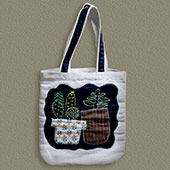Design Resource
Jute Bag Making, Bengaluru - Karnataka
Craft of the Golden Fiber
by
Prof. Bibhudutta Baral and Hariharasudan T.
The cultivation of jute begins by tilling the land (without using any fertilizers and pesticides)
After heavy shower of rain, seeds are sown, in 4 months’ time, they attain maturity (15 – 20 cm long) and are ready for harvesting. The plant stems are then about 2.5 to 3.5 meters tall and as thick as a finger. The stalks are cut-off, tied into bundles and retted (soaked) in water for about 20 days. The process of retting softens the tissues and permits the fibers to be separated. The fibers are then peeled off from the stalks in long strands and washed in low running water. The fibers lie beneath the bark around the woody core or ‘hull’. Then they are spread on thatched roofs to dry under the sun. Jute fiber is thus ready. Once the jute is woven, it is sent for dying, after dying it is sent for lamination. The entire jute roll is laminated with a Lower Density Polyethylene (LDPE) lining. After lamination is done, it goes to cutting department.
Fabric is arranged in layers and cut as per the product pattern. Cut fabric is marked according to product made and is sent to screen printing. Screen printing is done on cut fabric by arranging the fabrics on a large printing table. After the printing is done fabric is left to dry. Then it goes for stitching.
All the body parts such as body, gusset, zipper and handle of a bag are stitched together using stitching machine.
Finished bags are quality checked for any kind of errors. If any error is found then it is mended and rectified.













